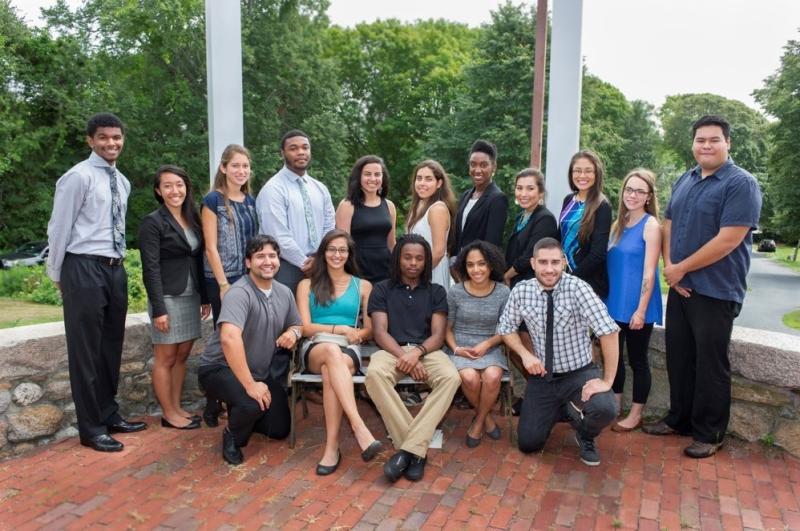How does NOAA increase its workforce diversity? One student at a time.
OK, maybe 16. That’s the number of students who participated in the Partnership Education Program last summer. The PEP program gives students from under-represented groups the mentorship and hands-on research experience that can help launch a career in the sciences.
Since the PEP program began in 2009, 107 students have spent a summer in Woods Hole, Massachusetts, conducting research in one of six participating institutions. In addition to NOAA Fisheries, these include the Woods Hole Oceanographic Institution, Woods Hole Research Center, Marine Biological Laboratory, Sea Education Association, and U.S. Geological Survey. NOAA Fisheries is the primary funder for the program.
PEP is the brainchild of Ambrose Jearld, a NOAA Fisheries biologist and the director of academic programs at NOAA’s Northeast Fisheries Science Center. Jearld has made it his mission to give young people the opportunities for mentorship that were unavailable to him when he was a student—and that might otherwise be out of reach for many students today.
In this way, the PEP program is helping to foster a diverse and inclusive federal workforce.
Significant Research Contributions
PEP students spend a summer—usually the summer before their senior undergraduate year—in Woods Hole, Massachusetts. After a period of intensive coursework, students intern in a laboratory that matches their interests, where they receive mentorship and hands-on research experience.
They also make significant research contributions, and in many cases have co-authored research papers coming out of their assigned labs.
“It gives students who might otherwise be overlooked a chance to show what they’ve got,” said Audy Peoples (PEP 2013), who interned at NOAA’s Northeast Fisheries Science Center, where he studied the feeding ecology of gray seals. Today Peoples is a master’s student at the University of Maryland Eastern Shore, where he is researching the effects of inorganic contaminants on marine mammal populations.
Most PEP students come from backgrounds that are under-represented in the marine sciences. Some come from small colleges, others from the Ivy League. Some have wanted to be scientists since early childhood, others had no idea. Many are the first in their families to attend college.
But PEP alumni have this in common: they are an immensely talented group of young men and women.
Because the program is only in its seventh year, many PEPsters are still in master’s or PhD programs. Not all will end up at NOAA, but those who do will not only increase the strength and capacity of NOAA’s workforce, they will also be researching some of the most pressing scientific questions that this agency is working to answer.

2014 PEP interns review a map of Antarctica. Photo: NOAA Fisheries
A Force Multiplier
If the goal is to make the NOAA workforce reflect the diversity of the American people, “the PEP program is a shining example of how to do that,” said John Bullard, the Greater Atlantic Regional Administrator for NOAA Fisheries who, in his previous capacity as President of Sea Education Association, helped Jearld establish PEP. “The key is to stick with it. This is not a problem that will be solved overnight.”
It will be solved one student at a time. But PEP alum are already reaching out to students coming up behind them, letting them know that there is excitement and opportunity—and a place for them—in the marine sciences.
“Dr. Jearld always tells us, ‘lift as you climb,’” said one PEP student.
In that way, the PEP program is its own force multiplier.
Might other forms of multiplication come into play? “Think of what would happen if the PEP program were duplicated at other science centers,” said Bullard. “This program works, and it’s ready to be scaled up.”
PEP Alumni
Learn more about a few Partnerships in Education alumni below.

Sanya Compton spent her 2009 PEP summer studying sea level rise at the U.S. Marine Policy Center in Woods Hole. Later, while working toward a master’s degree at Savannah State University, Compton was awarded a Knauss Fellowship. She spent her fellowship year working in the Office of the Science Advisory Board at NOAA Fisheries headquarters.
Compton is from St. Vincent and the Grenadines, where there are surprisingly few people with expertise in marine science and policy, she says. “I developed an interest in marine policy so I could contribute to better resource management on the islands.”
Compton will begin her PhD studies next year at the University of the West Indies, where her research will focus on fisheries governance.

Andre Price had been working full-time for UPS for 5 years before deciding to pursue a career in the sciences. “There’s nothing wrong with working at UPS,” he says. “But I wanted something different.”
He enrolled in Elizabeth City State University in North Carolina, but describes his 2012 PEP internship as a turning point in his academic career. “It wasn’t just, go to a lab and learn how to use a pipette,” he says. “I got real research experience.”
Today Price is working toward a master’s degree at the University of Maryland Eastern Shore, where he researches the feeding ecology of black sea bass. His graduate studies are funded in part by NOAA’s Educational Partnership with Minority Serving Institutions program.

Kelly Luis got her first hands-on experience with remote sensing during her 2015 PEP internship at the Woods Hole Oceanographic Institution, where she analyzed data from NASA’s Orbiting Carbon Observatory. In the PEP program, she says, “you don’t just dip your feet. It’s a real plunge.”
Luis, a native Hawaiian, currently works full-time at WHOI using satellite sea surface temperature readings to model bottom water temperatures off the U.S. Northeast Shelf.
“For me, the most important thing is doing research that’s geared toward helping indigenous communities,” Luis says. She plans to eventually get a PhD and return to Hawaii to apply remote sensing to coral reef management.



